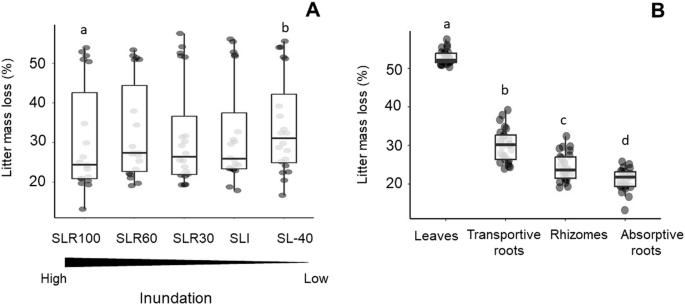盐沼枯落物分解因枯落物类型而异,因海平面淹没程度而异
IF 8.1
1区 地球科学
Q1 ENVIRONMENTAL SCIENCES
引用次数: 0
摘要
盐沼是全球最有效的蓝碳汇之一。由于对海平面上升条件下有机物(OM)分解过程的了解有限,这些碳的去向尚不确定。在一项原位操作实验中,我们比较了不同模拟海平面情景(通过改变淹没度)和不同枯落物类型(吸收根、细输导根、叶片和 Halimione portulacoide 根茎)下盐沼有机质的分解和质量,为期 170 天。枯落物的分解仅在淹没时间最长和最短的处理之间存在差异,而不同类型枯落物的分解则存在显著差异,吸收根释放的碳比其他枯落物少 40%。吸收根的木质素成分变化极小,且不受海平面上升情景的影响。我们的研究表明:(i) 目前对海平面上升的预测不太可能减少枯落物的分解;(ii) 区分枯落物类型可能有助于更好地评估盐沼的有机质动态。根据在法国温带盐沼进行的现场操纵实验,考虑到不同类型枯落物分解率的差异,可以改进对盐沼有机物分解动态的全球评估本文章由计算机程序翻译,如有差异,请以英文原文为准。

Salt marsh litter decomposition varies more by litter type than by extent of sea-level inundation
Salt marshes are among the most efficient blue carbon sinks worldwide. The fate of this carbon is uncertain due to limited knowledge about organic matter (OM) decomposition processes under sea-level rise. In an in-situ manipulative experiment, we compared salt marsh OM decomposition and quality across simulated sea-level scenarios (by modifying the inundation) and litter types (absorptive root, fine transportive root, leaves, and rhizomes of Halimione portulacoide) for 170 days. The litter decomposition varied only between the inundation treatments with the longest and shortest durations, while the decomposition differed significantly across litter types, with absorptive roots releasing up to 40% less carbon than other litters. Changes in lignin composition were minimal for absorptive roots and were unaffected by sea-level rise scenarios. Our study suggests that (i) current projections of sea-level rise are unlikely to decrease litter decomposition; (ii) separating litter types might lead to better assessments of salt marshes’ OM dynamics. Global estimates of salt marsh organic matter decomposition dynamics can be improved by taking into account the differences in decomposition rates among litter types, according to an in situ manipulative experiment in a French temperate salt marsh
求助全文
通过发布文献求助,成功后即可免费获取论文全文。
去求助
来源期刊

Communications Earth & Environment
Earth and Planetary Sciences-General Earth and Planetary Sciences
CiteScore
8.60
自引率
2.50%
发文量
269
审稿时长
26 weeks
期刊介绍:
Communications Earth & Environment is an open access journal from Nature Portfolio publishing high-quality research, reviews and commentary in all areas of the Earth, environmental and planetary sciences. Research papers published by the journal represent significant advances that bring new insight to a specialized area in Earth science, planetary science or environmental science.
Communications Earth & Environment has a 2-year impact factor of 7.9 (2022 Journal Citation Reports®). Articles published in the journal in 2022 were downloaded 1,412,858 times. Median time from submission to the first editorial decision is 8 days.
 求助内容:
求助内容: 应助结果提醒方式:
应助结果提醒方式:


